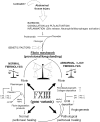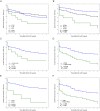Inherited genetic predispositions in F13A1 and F13B genes predict abdominal adhesion formation: identification of gender prognostic indicators
- PMID: 30446716
- PMCID: PMC6240050
- DOI: 10.1038/s41598-018-35185-x
Inherited genetic predispositions in F13A1 and F13B genes predict abdominal adhesion formation: identification of gender prognostic indicators
Abstract
Abdominal adhesions (AA) account for the most common complication of peritoneal surgery with bowel obstruction being the severest problem in the absence of effective predicting biomarkers. Anti-AA-barriers or adhesiolysis did not completely prevent bowel obstruction, although there is evidence they might reduce related complications requiring reoperation. In addition, gender-related predispositions have not been adequately investigated. We explored the role of coagulation Factor XIII (F13A1 and F13B subunit-genes) in patients following laparotomy, mostly median/lower median incision line. Globally, 426 patients (54%,♀), were PCR-SNP-genotyped for FXIIIA V34L (rs5985), FXIIIA P564L (rs5982), FXIIIA Y204F (rs3024477) and FXIIIB H95R (rs6003). Patients' clinical phenotypes were: Group-A (n = 212), those who developed AA, and 55.2% of them developed bowel obstruction (subgroup-A1), the remaining were subgroup-A2; Group B (n = 214) were those who did not develop AA (subgroup-B1; 53.3%) or symptoms/complications (subgroup-B2). Among different laparotomy, colon surgery associated with AA at a major extent (OR = 5.1; 3.24-7.8; P < 0.0001) with different gender scores (♀OR = 5.33; 2.32-12.23; P < 0.0001 and ♂OR = 3.44; 1.58-7.49; P < 0.0001). Among SNPs, P564L (OR = 4.42; 1.45-13.4; P = 0.008) and Y204F (OR = 7.78; 1.62-37.3; P = 0.01) significantly predicted bowel obstruction and survival-analyses yielded interesting gender distinctions (♀HR = 5.28; 2.36-11.8; P = 0.00005; ♂HR = 2.22; 1.31-3.85; P = 0.0034). Active compounds preventing AA belong to the anticoagulant/fibrinolysis areas, suggesting them candidate investigation targets. We identified novel prognostic markers to predict AA/bowel obstruction giving insights to design novel therapeutic and gender prevention programs.
Conflict of interest statement
The authors declare no competing interests.
Figures







References
Publication types
MeSH terms
Substances
LinkOut - more resources
Full Text Sources
Medical
Miscellaneous

